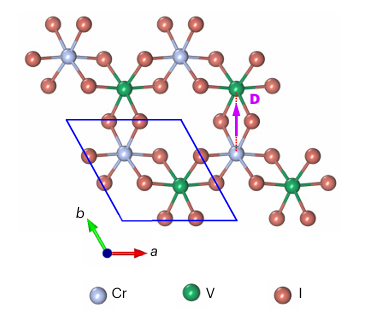Research teams led by ICQD member Prof. ZHANG Zhenyu, collaborated with Prof. Xiang Bin from University of Science and Technology of China (USTC), and Prof. SHENG Zhigao from High Magnetic Field Laboratory of Chinese Academy of Sciences (CAS), in collaboration with Xi'an Jiaotong University, and Henan Academy of Sciences, has proposed the concept of Topological Kerr Effect (TKE), and a new scheme of nondestructive/non-invasive probing of topological magnetic structures using optical means. The study was published in Nature Physics.
Skyrmion originated in particle physics and has been widely used to characterize a unique class of topological meta-excitations in condensed magnetic materials, whose spins are arranged in vortex-like or toroidal patterns in real space and have overall non-trivial topological properties. Skymion is capable of carrying the new generation of magnetic storage and logic devices. The topological Hall effect (THE) in electrical measurements stand as a strong discriminant for the existence of skymion, while the electrical measurements are usually only applicable to metallic systems. With the development of topological magnetic materials, there is an urgent need to make characterization means applicable to more systems, especially for the non-metallic system of skymion.
In 2017, scientists discovered two-dimensional ferromagnetic materials CrI3 and CrGeTe3 for the first time, which gathered much attention in the field. On this basis, researchers predicted, through first-principles calculations, a new class of 2D ferromagnetic materials, CrMX6 (M=Mn, V; X=I, Br), which are isomorphic to CrI3 and have non-trivial topological electronic states.
In this work, researchers successfully synthesized high-quality 2D CrVI6 single crystals using chemical vapor phase transport (CVP), characterized the magnetic structure of thin-layer samples of this system by the magneto-optical Kerr effect (MOKE), and observed systematic singular bumps. This feature is completely different from the M-H hysteresis loop of the bulk, but is highly similar to the topological Hall effect in the metallic magnetic skymion system.

Structure and DMI of CrVI6(Image by USTC)
Theoretical analysis also showed that the coexistence of two magnetic atoms, Cr and V, led to central inversion symmetry breaking and induced strong Dzyaloshinskii-Moriya interactions (DMI) under spin-orbit coupling, which was a prerequisite for forming skymion. Subsequently, through atomic-scale magneto dynamic simulations and theoretical calculations, it was revealed that the Kerr bumps were direct manifestations of the topological charge of the skyrmions. With the help of magnetic force microscope, researchers observed that, the coincidence of the magnetic field in CrVI6 range for the coexistence of topological magnetic structures in both striped and circular shapes, which further proved the topological property of the optical Kerr signal.
The technical advantages of strong magnetic field spectroscopy enable the spatial resolution, nondestructive testing, and contactless detection of skymionic excitations. The study provides a strong physical foundation and a powerful means of characterization for revealing the microscopic mechanism of topological magnetic structures.
Paper link: https://www.nature.com/articles/s41567-024-02465-5
